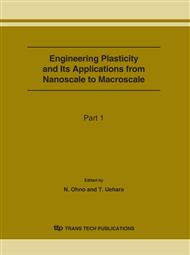p.803
p.811
p.817
p.823
p.829
p.835
p.841
p.847
p.853
Calibration of Texture-Adjusted Strain-Rate Potential and its Application
Abstract:
An accurate prediction of plastic anisotropy induced by initial texture in sheet metal forming operations depends on the constitutive models adopted. Models of engineering interest include both phenomenological formulations and crystal plasticity based on dislocation slip. In addition to the above two approaches that are commonly adopted in FE analysis, now an alternative is available which describes anisotropic behavior of polycrystalline sheet metals still by an analytic yield function to keep the computing time as low as possible but at the same time which also takes explicitly into account the crystallographic texture of the material to give a more precise description of plasticity anisotropy. However, the locus of such a yielding potential determined by constitutive coefficients upon invoking the rate-independent crystal plasticity may exhibit an unrealistic concave shape, which will make it impossible to obtain a convergent solution. To circumvent the difficulty, a detailed computation procedure is presented to calculate the constitutive coefficients based on rate-dependent crystal plasticity. The combination of the coefficients obtained with experimentally measured texture coefficients of an annealed FCC polycrystalline sheet metal will provide a complete constitutive characterization of the material. As an application of the calibrated model, the process of deep drawing by hemispherical punch is simulated, in which plastic anisotropy (earring) corresponding to typical texture type is observed, thus demonstrating the applicability of the coefficients found.
Info:
Periodical:
Pages:
829-834
Citation:
Online since:
June 2007
Authors:
Keywords:
Price:
Сopyright:
© 2007 Trans Tech Publications Ltd. All Rights Reserved
Share:
Citation:


